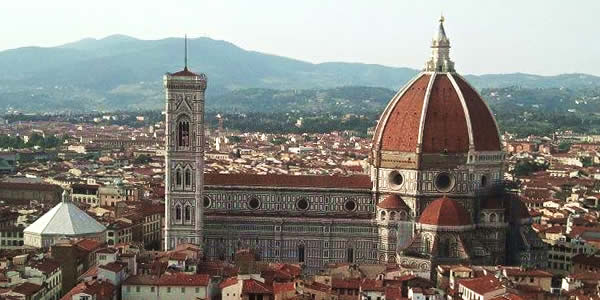
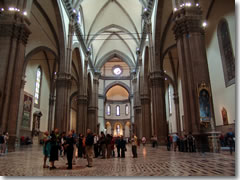
The nave of Florence's Duomo. Fun fact: The first few windows are eternally dark because the church was redesigned partway through construction and the interior and exterior architecture doesn't actually match up.Florence's cathedral is sort of inside out, prettily decorated on the outside with a festive cladding of white, green, and pink marble but inside rather spare, almost barren.
That's not to say the Duomo isn't worth visiting. Just that its interior is not as spectacular as you might expect from so famous a church.
What really makes the Duomo so famous are everything but the church itself: the famous dome by Brunelleschi, the adjacent bell tower and baptistery, the sculptures in the Duomo museum around back.
In all, the Duomo is probably best to enjoy from the little piazza out in front, where tourists flock, street musicians and artists ply their trades, students strum guitars, and Florentines weave their way through the crowds with the evening's shopping in hand. (Though in 2012 local authorities tried to break up the scene by cordoning off the Duomo steps during daylight hours so you cannot sit on them.)
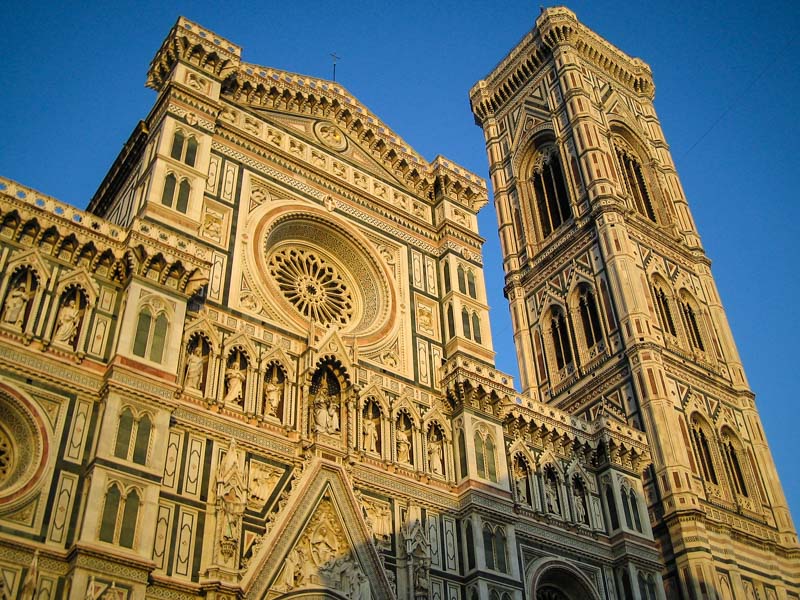
The festive facade of the Duomo is a particolored Neo-Gothic take on what the overwrought imaginations of 19th century decorators imagined the cathedral builders would have wanted.
Until 1871, the cathedral didn't have a proper facade, though every major architect and artist of the Renaissance submitted plans or models for it (none were ever executed, but some are preserved in the Duomo Museum).
Know how you can tell the facade is a 19th century mock-up? The color scheme is a celebration of the then-new Italian flag, done all in red, white, and green to honor the freshly-minted Kingdom of Italy (of which Florence was, briefly, the capital, from 1865–70).

Paolo Uccello's fresco of the "Monument" for Giovanni Acuto in the Florence cathedral.By the late 13th century, Florence was feeling peevish: Its archrivals Siena and Pisa sported huge new Duomos filled with art while it was saddled with the tiny 5th- or 6th-century Santa Reparata as a cathedral.
So, in 1296, the city hired Gothic genius Arnolfo di Cambio to design a new Duomo, to be named Santa Maria dei Fiori ("St. Mary of the Flowers"—a play on the origins of Florence's original Latin name, Fiorentina, or "flower place"). Arnolfo di Cambio and he began raising the facade and the first few bays before his death in 1302.
Work continued under the auspices of the rich and powerful Wool Guild and architects Giotto (who concentrated on the bell tower) and Francesco Talenti (who finished up to the drum of the dome and in the process greatly enlarged Arnolfo's original plan).
The Duomo was actually built around the old church of Santa Reparata so it could remain open and performing mass during construction of the new, bigger cathedral. For more than 70 years, Florentines entered their tiny old church through the freestanding facade of the grand new one. However, in 1370 the original Santa Reparata was torn down when the bulk of the Duomo—except the dome—was finished.
Ever the fiscal conservatives, Florentines started clamoring to see some art as soon as the new facade's front door was completed in the early 1300s—to be sure their investment would be more beautiful than rival cathedrals. Gaddo Gaddi was commissioned to mosaic an Enthronement of Mary in the lunette above the inside of the main door, and the people were satisfied.
The stained-glass windows set in the facade were designed by Lorenzo Ghiberti, and Paolo Uccello, a painter obsessed by the newly developed perspective, frescoed the huge hora italica clock with its four heads of Prophets in 1443.
At a right-aisle pier are steps leading down to the cripta (crypt), contianing excavations of the old Santa Reparata. In 1972, a tomb slab inscribed with the name Filippo Brunelleschi was discovered there (visible through a gate)—to this day, the only Florentine honored to be buried udner the new cathedral (though older graves are also here). However, unless you're interested in the remains of some ancient Roman houses and parts of the paleo-Christian mosaics from Santa Reparata's floor, the admission isn't worth it.
Against the left-aisle wall are the Duomo's only frescoes besides those in the dome.
The earlier one to the right is the greenish Memorial to Sir John Hawkwood (1436), an English condottiere (mercenary commander) whose name the Florentines mangled to Giovanni Acuto when they hired him to rough up their enemies. Before he died, or so the story goes, the mercenary asked to have a bronze statue of himself riding his charger to be raised in his honor. Florence solemnly promised to do so but, in typical tightwad style, after Hawkwood's death hired the master of perspective and illusion Paolo Uccello to paint a trompe-l'oeil "equestrian monument" instead—much cheaper than casting a statue in bronze. Again, Florentines are a famously frugal lot.
Andrea Castagno copied this painting-as-equestrian-statue idea 20 years later when he frescoed a Memorial to Niccolò da Tolentino next to Uccello's work. Near the end of the left aisle is Domenico di Michelino's Dante Explaining the Divine Comedy (1465).
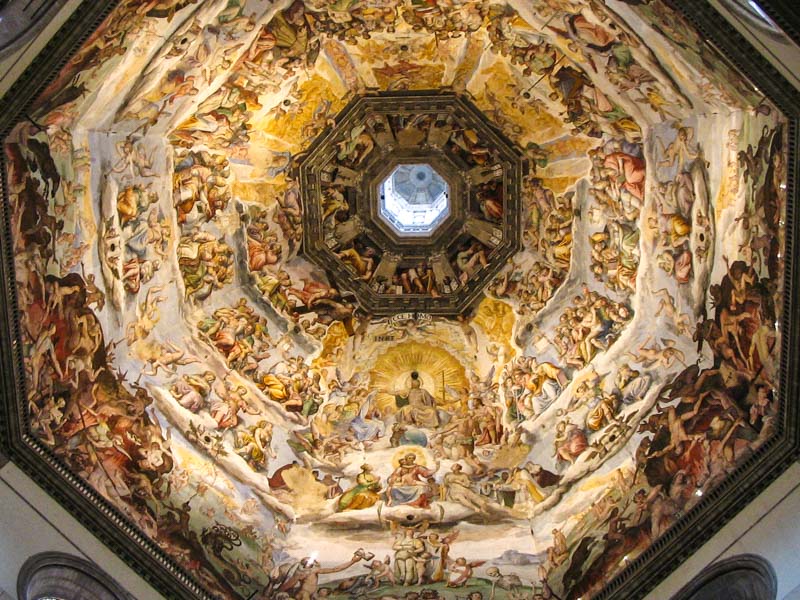
The frescoes on the interior of the dome were designed by Giorgio Vasari but painted mostly by his less-talented student Frederico Zuccari by 1579. They are not teribly good, but are rather colorful—and packed with agreeably gruesome scenes of the Damned in Hell in the Last Judgment bit (you get to see them up close as part of your climb up to the dome).
These frescoes were subjected to a thorough cleaning completed in 1996, which many people saw as a waste of restoration lire when so many more important works throughout the city were waiting to be salvaged. The scrubbing did, however, bring out Zuccari's only saving point—his innovative color palette.
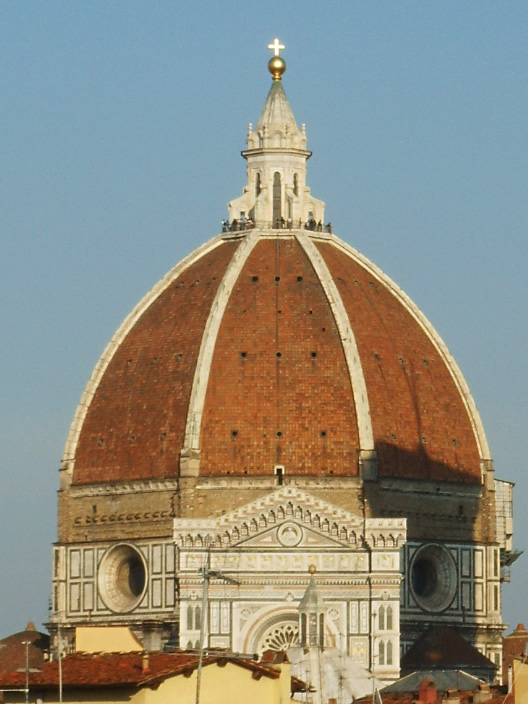
Brunelleschi's Dome on the cathedral of Florence. (Photo by Sailko)Hands down, everyone's favorite thing to do at the Duomo is to climb the 348-foot-high dome (la cupola del Duomo), which dominates the skyline and is a symbol of Florence itself. Climb it not only for the great panorama across the city you get from the top, but also so you can admire, from the inside, Brunelleschi's architectural marvel.
You actually clamber up between the dome's two onion-like layers—and in the process get some great up-close views of those crazy Zuccari frescoes (skilled though the frescoes may not be, the scene of the Damned being tortured in Hell is certainly imaginative).
The dome actually presented something of an engineering conundrum for the cathedral authorities in the early 15th century.
A yawning space had been left open for a dome that—at 45m (150 feet) wide—would be far larger than any attempted since antiquity. Unfortunately, no architect of the time had any idea how to span the space.
No architect, that is, save Brunelleschi, who unlocked the secrets of Rome's Pantheon and, between 1420 and 1436, creatd the largest free-standing dome since antiquity, a masterpiece of architecture, engineering, and lyrical grace.
» Read the full story on the Brunelleschi page.
At the base of the dome, just above the drum, Baccio d'Agnolo began adding a balcony in 1507. One of the eight sides was finished by 1515, when someone asked Michelangelo—whose artistic opinion was by this time taken as cardinal law—what he thought of it. The master reportedly scoffed, "It looks like a cricket cage."
Work was immediately halted, and to this day the other seven sides of the top of the drum remain rough brick.
Though these days the catehdral authorities like to limit tourists to just the nave of the church, roping off the transept to reserve it for for actual worshippers, if you can get through the ropes, make your way to the back left corner behind the altar to admire the Nuova Sagrestia (New Sacristy).
Lorenzo de' Medici was attending Mass in the Duomo one April day in 1478 with his brother Giuliano when they were attacked in the infamous Pazzi Conspiracy. The conspirators, egged on by the pope and led by a member of the Pazzi family, old rivals of the Medici, fell on the brothers at the ringing of the sanctuary bell. Giuliano was murdered on the spot—his body rent with 19 wounds—but Lorenzo vaulted over the altar rail and sprinted for safety into the New Sacristy, slamming the bronze doors behind him.
Those doors were cast from 1446 to 1467 by Luca della Robbia, his only significant work in the medium (he and his descendents specialized in glazed terracotta). Earlier, Luca had provided a lunette of the Resurrection (1442) in glazed terra cotta over the door, as well as the lunette Ascension over the south sacristy door.
The interior of the New Sacristy is filled with beautifully inlaid wood cabinet doors.
Piazza del Duomo/Piazza San Giovanni
tel. +39-055-230-2885
www.operaduomo.firenze.it
Church:
Mon–Fri 10am–5pm
(Thurs: closes at 4:30pm Jan–Apr, Nov, and Dec; 4pm in May and Oct; 5pm Jul–Sep)
Sat 10am–4:45pm
Sun and religious holidays 1:30–4:45pm (mornings, tourists are not allowed in—unless you attend mass)
Cupola (Brunelleschi's dome):
Mon-Fri 8:30am–7pm
Sat 8:30am–5:40pm
Sun 1–3:30pm
Church: Free
Cupola (dome)/Cripta (excavations): €15
(covered by the Duomo group cumulative ticket)
With Firenze Card: All free
Free tours every 40 minutes
Bus: C2; 14, 23, C1
Hop-on/hop-off: Teatro Verdi (A)
Planning your day: It should take about 20–30 minutes inside the Cathedral itself, another 20–30 minutes in and around the Baptistery.
Climbing either Brunelleschi's dome (463 steps) or Giotto's bell tower (414 steps) will take about an hour each.
The Duomo museum will eat up 45–90 minutes of your time, depending on how into it you get.
For the church, the last entry is just before closing.
For Brunelleschi's dome, the last entry is 40 minutes before closing.
For the Santa Reparata crypt excavations, the last entry is 30 minutes before closing.
The ticket allows you to enter each sight two times, if you wish, but sadly is only good for the day you buy it, so you have to do them all at once.
If you happen to visit on a Sunday, arrive just after early lunch to hit the baptistery first—as it's open only 8:30am to 2pm—then do the cathedral once it reopens after morning mass.
Take a guided tour of the Florence cathedral with one of our partners:
While the cathedral itself is free, everything else in the Duomo group are on a single, €15 cumulative ticket that covers all of the Opera del Duomo group sights: the Duomo itself, Cupola (cathedral dome) Baptistry, Campanile (Belltower), S. Reparata (excavations under the Duomo), and the newly repoened the Museo.
Sadly, the ticket is is only good for the day you buy it, so you have to do them all at once.
Note: All the sights in the Duomo group are also covered by the Firenze Card. » more
You can attend mass: Sundays at 7:30am, 9am, 10:30am (in Gregorian chant), noon, and 6pm (Vespers with chant: 5:30pm). Mon–Sat smaller masses are held at 7:30am, 8:30am, 9:30am, and 6pm.
(Weekdays, there are also a mass held in the adjacent Baptistery at 10:30am and 11:30am). There is also a mass in English Saturdays at 5pm (first Sat of the month in the Misericordia on Piazza Duomo).
For more: www.coordinamentochiesedifirenze.it
Share this page
Search ReidsItaly.com
Piazza del Duomo/Piazza San Giovanni
tel. +39-055-230-2885
www.operaduomo.firenze.it
Church:
Mon–Fri 10am–5pm
(Thurs: closes at 4:30pm Jan–Apr,Nov and Dec; 4pm in May and Oct; 5pm Jul–Sep)
Sat 10am–4:45pm
Sun and religious holidays 1:30–4:45pm (mornings, tourists are not allowed in—unless you attend mass)
Cupola (Brunelleschi's dome):
Mon-Fri 8:30am–7pm
Sat 8:30am–5:40pm
Sun 1–3:30pm
Church: Free
Cupoola (dome)/Cripta (excavations): €15
(covered by the Duomo group cumulative ticket)
With Firenze Card: All free
Free tours every 40 minutes
Bus: C2; 14, 23, C1
Hop-on/hop-off: Teatro Verdi (A)